.
1.01.2016
Looking Back at the ‘Year of Pluto’
NASA’s New Horizons spacecraft will mark New Year’s some 125 million miles beyond Pluto, far removed from the excitement and activity that accompanied its historic flight through the Pluto system just five months ago.
The intrepid probe continues to send volumes of pictures and other data from the July 14 encounter – stashed on its digital recorders – over a radio link to Earth stretching billions of miles. And as the pictures reach home, they remind us that 2015 was the year a small world on the planetary frontier captured our hearts, thanks to a determined and inspired team of government, academic and commercial partners determined to expand the frontiers of science and explore an entirely new realm of the solar system.
“What an amazing year, and an amazing experience,” said Glen Fountain, the New Horizons project manager at the Johns Hopkins University Applied Physics Laboratory (APL) in Laurel, Maryland. “The New Horizons team worked so hard for so long, and to see it all come together was incredible.”
“The year 2015 had been in our team’s future for so long, it’s hard to believe that it’s soon to be in our past,” said Alan Stern, New Horizons principal investigator from the Southwest Research Institute (SwRI) in Boulder, Colorado. “But what a year it was – we explored Pluto, and made history doing it; we showed that first-time exploration of new planets gets a viral popular response from the public; and we found that small planets can be as complex as big ones like Mars.
“So while 2015 may be over, we’re not done on New Horizons,” he continued. “We’ll be receiving new data every week until at least October 2016, and as a result the exploration of the Pluto system continues even as we fly farther into the Kuiper Belt!”
.

New Horizons Project Manager Glen Fountain gives a Pluto flyby assessment during a press conference on July 14, 2015. (Credit: NASA/Bill Ingalls)
.
As the Encounter Began . . .
New Horizons began its long-awaited encounter with Pluto in January – nine years after launch – entering the first of several approach phases that culminated with the first close-up flyby of the Pluto system six months later.
A long-range photo shoot that began Jan. 25 provided mission scientists with a continually improving look at the dynamics of Pluto and its moons – and those images played a critical role in navigating the spacecraft across the remaining 135 million miles (220 million kilometers) to Pluto, and helping mission scientists search for debris that might have impeded New Horizons at flyby.
Over the next few months, the onboard Long Range Reconnaissance Imager (known as LORRI) took hundreds of pictures of Pluto against star fields to refine the team’s estimates of New Horizons’ distance to Pluto. Though the Pluto system resembled little more than bright dots in the camera’s view until May, mission navigators used those pictures to design course-correction maneuvers and aim the spacecraft toward its flyby target point.
.

This movie was made from images taken Jan. 25-31, 2015, as part of a New Horizons optical navigation campaign to better refine the locations of Pluto and Charon in preparation for the spacecraft’s close encounter with the small planet and its five moons. (Credit: NASA/APL/SwRI)
.
In April the team added several significant observations of the Pluto system, including the first color and spectral observations of Pluto and its moons, and the first ultraviolet observations to study the surface and atmosphere of Pluto and the surface of its largest moon, Charon. New Horizons also started the series of long-exposure images designed to help the team spot additional moons or rings in the Pluto system – which they never did find.
After seven weeks of detailed searches for dust clouds, rings, and other potential hazards, the New Horizons team decided the spacecraft would remain on its original path through the Pluto system instead of making a late course correction to detour around any hazards. Because New Horizons was traveling at approximately 31,000 miles (about 50,000 kilometers) per hour, a particle as small as a grain of rice could have been lethal.
.
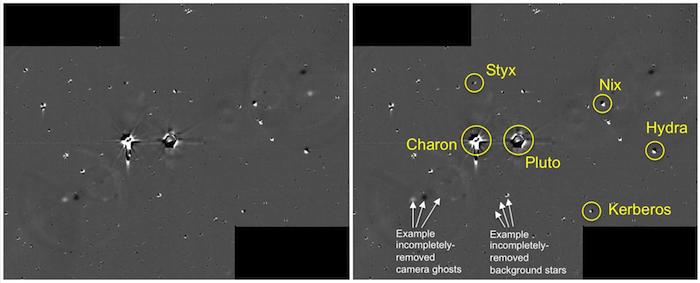
This illustration shows some of the final images used to determine that the coast was clear for New Horizons’ flight through the Pluto system. These images show the difference between two sets of 48 combined 10-second exposures with the Long Range Reconnaissance Imager (LORRI), taken June 26, 2015, from a range of 21.5 million kilometers (approximately 13 million miles) to Pluto. (Credit: NASA/APL/SwRI)
.
Mission officials breathed a collective sigh of relief. "Not finding new moons or rings present is a bit of a scientific surprise to most of us," Stern said on July 1. "But as a result, no engine burn is needed to steer clear of potential hazards … We are 'go' for the best of our planned Pluto encounter trajectories."
By then, Pluto was also starting to come into clearer view. The distinct “faces” of both Pluto and Charon were becoming apparent, including Pluto’s now-famous heart shaped plain named Tombaugh Regio.
.
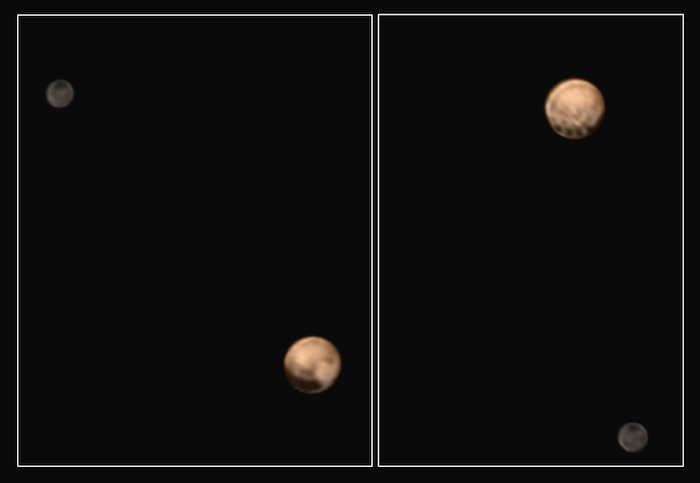
Pluto shows two remarkably different sides in these color images of the planet and its largest moon, Charon, taken by New Horizons on June 25 and June 27, 2015. (Credit: NASA/APL/SwRI)
.
A Mission Save
New Horizons had traveled farther than any spacecraft to reach its primary target – and while it spent about two-thirds of that long journey in hibernation, the team was designing and practicing every maneuver and science operation of the Pluto encounter, and getting to know its spacecraft inside and out.
That preparation paid off just before the flyby. On July 4, while attempting to process commands sent from home and compress stored science data at the same time, the spacecraft’s main computer overloaded and, as designed, switched to its backup processor. This put New Horizons into a “safe mode” where it stopped performing science, pointed to Earth and quietly awaited word from operators on the next move.
.
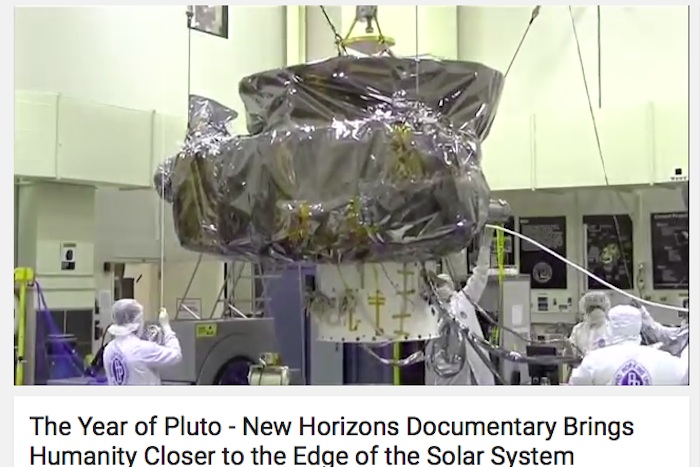
Watch the New Horizons team prepare for its historic encounter with Pluto in “The Year of Pluto.”
.
The recovery was fast and thorough; mission engineers immediately identified the problem and reestablished contact within two hours. By July 7, the intricate set of flyby commands – the critical directions for New Horizons’ science instruments – was reloaded and ready to go.
“Looking back over the last year, there are many things that stand out, but the most revealing to me is the awesome power of a team,” said APL’s Alice Bowman, the New Horizons mission operations manager. “In my opinion, it was and continues to be the reason for the huge success of New Horizons. As exemplified by New Horizons, a team is so much more than the sum of its members.”
.

Guests and New Horizons team members count down to the spacecraft’s closest approach to Pluto on July 14, 2015, at the Johns Hopkins University Applied Physics Laboratory in Laurel, Maryland. (Credit: NASA/Bill Ingalls)
.
Celebrating Science and Exploration
New Horizons mission central, for the week of July 12-18, was the Kossiakoff Center at APL. Nearly 250 members of the media, 1,600 guests and hundreds of staff were on hand for panel discussions, press conferences and related activities; a full NASA TV set was built on the auditorium floor for the flyby coverage that was broadcast and webcast to the world.
New Horizons was actually out of contact with Earth during its closest approach to Pluto at approximately 7:50 a.m. EDT on July 14. But the team, joined by guests and an international TV audience, marked the flyby with a raucous countdown that rivaled New Year’s Eve in Times Square. Network morning shows beamed live images of U.S. flags waving and cheers and hugs around the room. Later that morning the team revealed a stunning, immediately iconic image of Pluto, the last photo New Horizons took and transmitted before entering flyby silence.
.
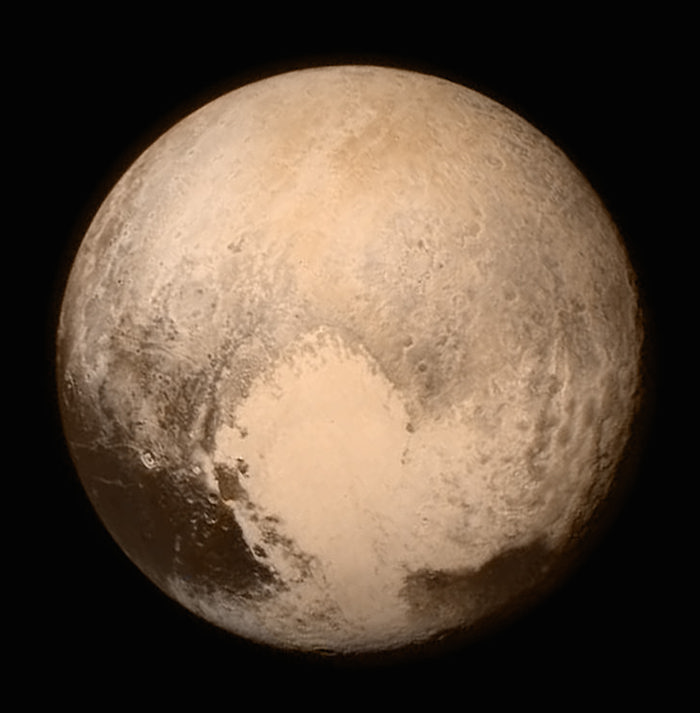
Pluto nearly fills the frame in this image from the Long Range Reconnaissance Imager (LORRI) aboard New Horizons, taken on July 13, 2015, when the spacecraft was 476,000 miles (768,000 kilometers) from the surface. This is the last and most detailed image sent to Earth before the spacecraft’s closest approach to Pluto on July 14. The color image has been combined with lower-resolution color information from the Ralph instrument that was acquired earlier on July 13. (Credit: NASA/APL/SwRI)
.
But the most critical transmission on July 14 didn’t include a picture; it was the burst of telemetry, set to arrive in the New Horizons Mission Operations Center just before 9 p.m., indicating the spacecraft was healthy and did its job. The suspense was short-lived, as the transmission – sent from New Horizons more than four hours earlier – came right on time. “We have carrier lock,” announced mission operations chief Bowman, meaning NASA’s Deep Space Network had linked up to New Horizons.
Then came the telemetry, sparking applause in Mission Ops. After a quick poll of the spacecraft systems team – where all indicated New Horizons was “green” – Bowman made the call: “We have a healthy spacecraft, we have collected all the data, and we are outbound from Pluto.”
A jubilant Stern burst into the room, hugged Bowman and started a cheer of “U-S-A, U-S-A” among the ops team. He was followed by APL Director Ralph Semmel, NASA Associate Administrator John Grunsfeld and Administrator Charles Bolden, who all offered congratulations.
.
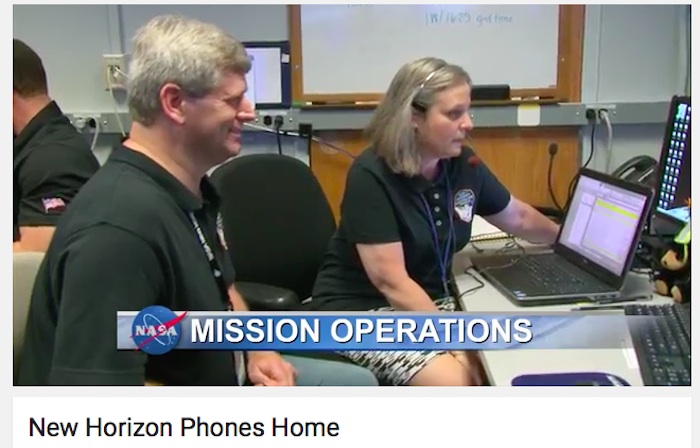
Watch Mission Operations Manager Alice Bowman and the operations team confirm the success of the Pluto flyby on July 14, 2015.
.
Bowman, after the hugs and handshakes, looked around the room. “This is just fantastic,” she said. “Just like we planned it, just like we practiced. We did it!”
Bowman then led the operations team on a walk to the packed Kossiakoff Center auditorium, where they and the rest of the New Horizons team received a standing ovation to kick off a press conference that more resembled a Super Bowl celebration. All that was missing was a trophy and a call from the White House – though President Obama did tweet his congratulations to NASA and the team.
“Inspiration like that provided by New Horizons will keep interest strong for the next generation to make their own giant leaps,” Bolden said to open the press conference. “This is a historic win for science and exploration.”
The first close-up pictures, showing Pluto’s surface and some of its moons in incredible detail, came back the next day. Over the next several days the science team, camped out at APL since June, scoured data and images of Pluto that revealed nitrogen ice flowing across the surface, mountain ranges that rival the Rockies, and areas that might still be geologically active.
Other results since then – which have already been included in peer-reviewed journal articles and presented at two major science meetings, the American Geophysical Union and AAS Division for Planetary Sciences – are revealing Pluto and its moons to be unexpectedly complex and beautiful, yet unlike any worlds we’ve ever encountered in our solar system.
Still, for science team member Fran Bagenal, of the University of Colorado, Boulder, the magical public reaction to the images of Pluto remains a favorite memory. “Pluto has always been a favorite planet for many people – particularly kids. But when I show the images to friends, relatives and public audiences, everyone just smiles, shakes their heads and says, ‘Wow! That’s so cool!’”
.
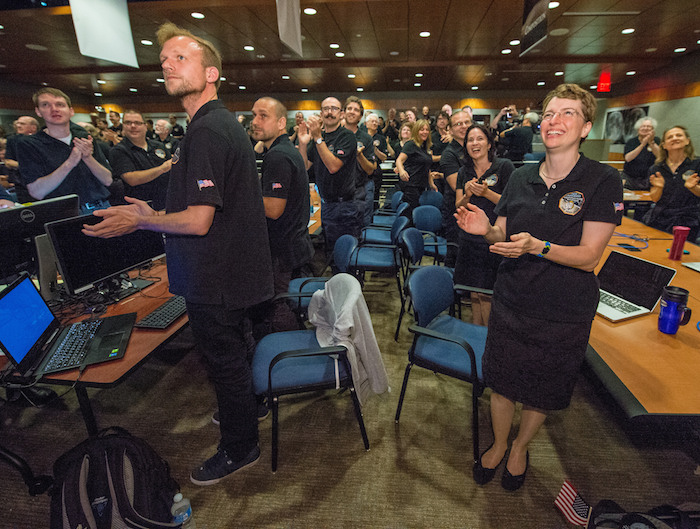
Members of the New Horizons science team react to seeing the spacecraft's last and sharpest image of Pluto before closest approach later in the day, July 14, 2015 at the Johns Hopkins University Applied Physics Laboratory in Laurel, Maryland. (Credit: NASA/Bill Ingalls)
.
Exploration on the Frontier
On Nov. 4, the New Horizons team completed the last of four targeting maneuvers that set the spacecraft on course for a Jan. 1, 2019 encounter with 2014 MU69. This ancient body in the Kuiper Belt is more than a billion miles beyond Pluto; New Horizons will explore it if NASA approves an extended mission.
The maneuvers were the most distant trajectory corrections ever performed by any spacecraft; they also were the mission's largest and longest, and carried out in a succession faster than any sequence of previous New Horizons engine burns. And they were incredibly accurate, performing almost exactly as they were designed and setting New Horizons on the course mission designers predicted.
The science team hopes to explore even closer to MU69 than New Horizons came to Pluto on July 14, which was approximately 7,750 miles. The team will submit its proposal for an extended mission in April.
“New Horizons was a once-in-a-lifetime mission, and it felt as if that lifetime – all the decades of proposing, building, planning and flying – got compressed into those July days of intense excitement and the astonishment at the results,” said Joel Parker, a New Horizons co-investigator from SwRI. “ I feel incredibly lucky to have been a part of this event that simultaneously brings to the end five decades of solar system ‘first’ explorations, and starts a new epoch of exploring further reaches of the solar system; we didn't even know that ‘third zone,’ the Kuiper Belt, existed when humans started to send spacecraft to explore the planets. It makes me wonder: What new places in our solar system will we discover in the next 50 years?”
.
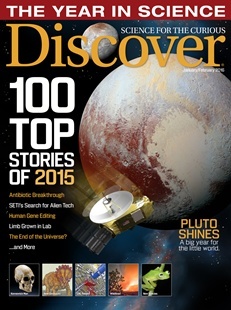
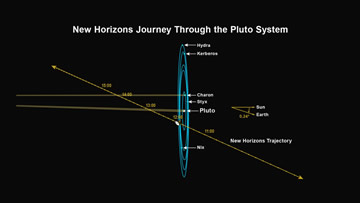
Incredible Aim
Timing and accuracy were critical for all New Horizons flyby observations, since commands for the science observations were stored in the spacecraft’s computers and programmed to “execute” at exact times. To guide New Horizons to the right place and time the team used a combination of radio-tracking data of the spacecraft and, in the months before the flyby, range-to-Pluto measurements made by optical navigation images of Pluto taken by New Horizons itself.
So after 9.5 years and 3 billion miles, how did they do? How about just 90 seconds and 100 miles from their projected target. “We did so well, I almost don’t believe it,” Project Manager Glen Fountain said. “We were aiming for a 60-by-90 mile box [near Pluto], and we almost flew right through the center of it. That’s like hitting a hole-in-one from New York to Los Angeles.”
Quelle: NASA
.
Update: 12.02.2016
.
Putting Pluto’s Geology on the Map
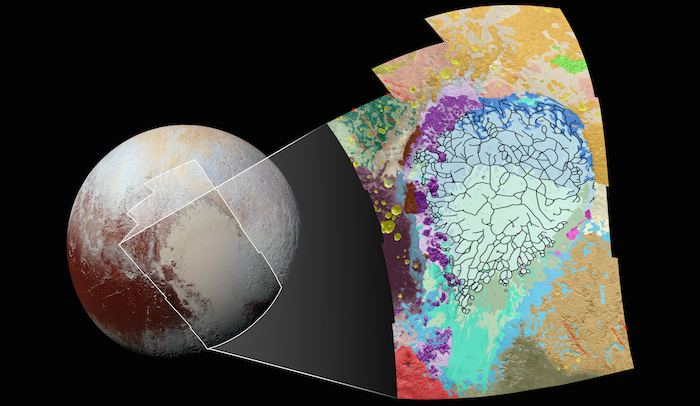
Images from NASA’s New Horizons mission are showing that the surface of Pluto possesses an astonishing and unexpected geological diversity. To help make sense of this complexity and to piece together how Pluto’s surface has formed and evolved over time, mission scientists construct geological maps like the one shown in this image.
This map covers a portion of Pluto’s surface that measures 1,290 miles (2,070 kilometers) from top to bottom, and includes the vast nitrogen-ice plain informally named Sputnik Planum and surrounding terrain. As the key beside the map shows, the map is overlain with colors that represent different geological terrains. Each terrain, or unit, is defined by its texture and morphology – smooth, pitted, craggy, hummocky or ridged, for example. How well a unit can be defined depends on the resolution of the images that cover it. All of the terrain in this map has been imaged at a resolution of approximately 1,050 feet (320 meters) per pixel or better, meaning scientists can map units with relative confidence.
The various blue and greenish units that fill the center of the map represent different textures seen across Sputnik Planum, from the cellular terrain in the center and north, to the smooth and pitted plains in the south. The black lines represent the troughs that mark the boundaries of cellular regions in the nitrogen ice. The purple unit represents the chaotic, blocky mountain ranges that line Sputnik’s western border, and the pink unit represents the scattered, floating hills at its eastern edge. The possible cryovolcanic feature informally named Wright Mons is mapped in red in the southern corner of the map. The rugged highlands of the informally named Cthulhu Regio is mapped in dark brown along the western edge, and is pockmarked by many large impact craters, mapped in yellow.
By studying how the boundaries between units crosscut one another, mission scientists can determine which units overlie others, and assemble a relative chronology for the different units. For example, the yellow craters (at left, on the western edge of the map) must have formed after their surrounding terrain. Producing such maps is important for gauging what processes have operated where on Pluto, and when they occurred relative to other processes at work.
The base map for this geologic map is a mosaic of 12 images obtained by the Long Range Reconnaissance Imager (LORRI) at a resolution of 1,280 feet (about 390 meters) per pixel. The mosaic was obtained at a range of approximately 48,000 miles (77,300 kilometers) from Pluto, about an hour and 40 minutes before New Horizons’ closest approach on July 14, 2015.
Quelle: NASA
-
Update: 19.02.2016
.
Pluto’s ‘Hulk-like’ Moon Charon: A Possible Ancient Ocean?
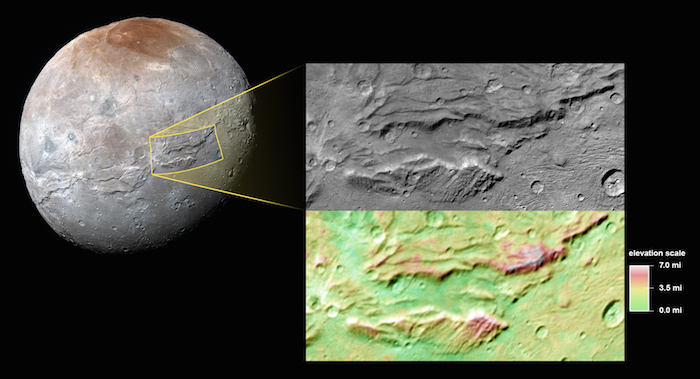
Images from NASA’s New Horizons mission suggest that Pluto’s largest moon, Charon, once had a subsurface ocean that has long since frozen and expanded, pushing out on the moon’s surface and causing it to stretch and fracture on a massive scale.
The side of Charon viewed by the passing New Horizons spacecraft in July 2015 is characterized by a system of “pull apart” tectonic faults, which are expressed as ridges, scarps and valleys—the latter sometimes reaching more than 4 miles (6.5 kilometers) deep. Charon’s tectonic landscape shows that, somehow, the moon expanded in its past, and –like Bruce Banner tearing his shirt as he becomes the Incredible Hulk – Charon’s surface fractured as it stretched.
Charon’s outer layer is primarily water ice. When the moon was young this layer was warmed by the decay of radioactive elements, as well as Charon’s own internal heat of formation. Scientists say Charon could have been warm enough to cause the water ice to melt deep down, creating a subsurface ocean. But as Charon cooled over time, this ocean would have frozen and expanded (as happens when water freezes), pushing the surface outward and producing the massive chasms we see today.
The top segment focuses on a section of the feature informally named Serenity Chasma, part of a vast equatorial belt of chasms on Charon. In fact, this system of chasms is one of the longest seen anywhere in the solar system, running at least 1,100 miles (about 1,800 kilometers) long and reaching 4.5 miles (7.5 kilometers) deep. By comparison, the Grand Canyon is 277 miles (446 kilometers) long and just over a mile (1.6 kilometers) deep.
The lower portion of the image shows color-coded topography of the same scene. Measurements of the shape of this feature tell scientists that Charon’s water-ice layer may have been at least partially liquid in its early history, and has since refrozen.
This image was obtained by the Long-Range Reconnaissance Imager (LORRI) on New Horizons. North is up; illumination is from the top-left of the image. The image resolution is about 1,290 feet (394 meters) per pixel. The image measures 240 miles (386 kilometers) long and 110 miles (175 kilometers) wide. It was obtained at a range of approximately 48,900 miles (78,700 kilometers) from Charon, about an hour and 40 minutes before New Horizons’ closest approach to Charon on July 14, 2015.
Quelle: NASA
-
Update: 26.02.2016
.
The Frozen Canyons of Pluto’s North Pole
This ethereal scene captured by NASA’s New Horizons spacecraft tells yet another story of Pluto’s diversity of geological and compositional features—this time in an enhanced color image of the north polar area.
.
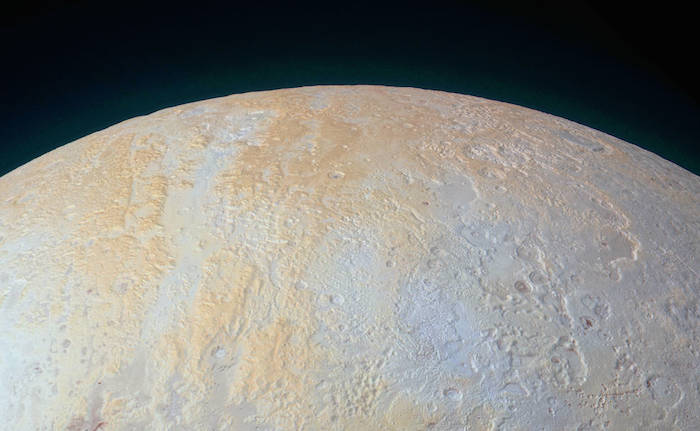
Long canyons run vertically across the polar area—part of the informally named Lowell Regio, named for Percival Lowell, who founded Lowell Observatory and initiated the search that led to Pluto’s discovery. The widest of the canyons (yellow in the image below) – is about 45 miles (75 kilometers) wide and runs close to the north pole. Roughly parallel subsidiary canyons to the east and west (in green) are approximately 6 miles (10 kilometers) wide. The degraded walls of these canyons appear to be much older than the more sharply defined canyon systems elsewhere on Pluto, perhaps because the polar canyons are older and made of weaker material. These canyons also appear to represent evidence for an ancient period of tectonics.
A shallow, winding valley (in blue) runs the entire length of the canyon floor. To the east of these canyons, another valley (pink) winds toward the bottom-right corner of the image. The nearby terrain, at bottom right, appears to have been blanketed by material that obscures small-scale topographic features, creating a ‘softened’ appearance for the landscape.
Large, irregularly-shaped pits (in red), reach 45 miles (70 kilometers) across and 2.5 miles (4 kilometers) deep, scarring the region. These pits may indicate locations where subsurface ice has melted or sublimated from below, causing the ground to collapse.
The color and composition of this region – shown in enhanced color – also are unusual. High elevations show up in a distinctive yellow, not seen elsewhere on Pluto. The yellowish terrain fades to a uniform bluish gray at lower elevations and latitudes. New Horizons' infrared measurements show methane ice is abundant across Lowell Regio, and there is relatively little nitrogen ice. “One possibility is that the yellow terrains may correspond to older methane deposits that have been more processed by solar radiation than the bluer terrain,” said Will Grundy, New Horizons composition team lead from Lowell Observatory, Flagstaff, Arizona.
This image was obtained by New Horizons’ Ralph/Multispectral Visible Imaging Camera (MVIC). The image resolution is approximately 2,230 feet (680 meters) per pixel. The lower edge of the image measures about 750 miles (1,200 kilometers) long. It was obtained at a range of approximately 21,100 miles (33,900 kilometers) from Pluto, about 45 minutes before New Horizons’ closest approach on July 14, 2015.
.
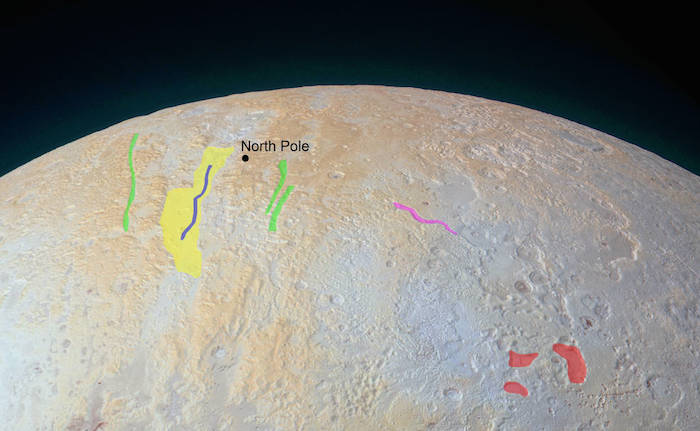
Quelle: NASA
-
Update: 4.03.2016
.
NASA may have found snow-covered mountains on Pluto
Don't book your ski vacation yet; we hear airfare to Pluto is exorbitant.
.
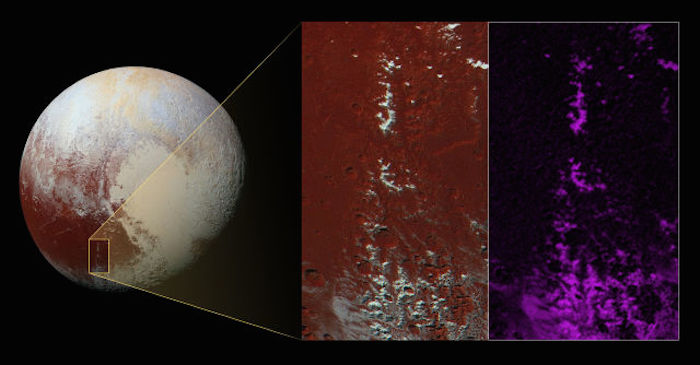
From visual images and a spectral analysis, scientists think methane ice caps some of Pluto's mountains.
-
After studying images and data that characterize a range of mountains that run for 420km across Pluto's Cthulhu feature, planetary scientists now think they are seeing peaks capped with methane snow.
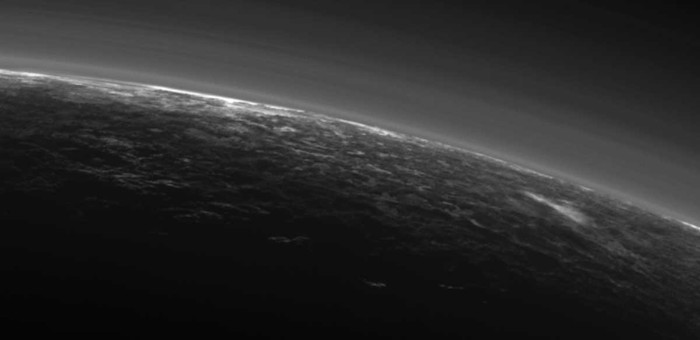
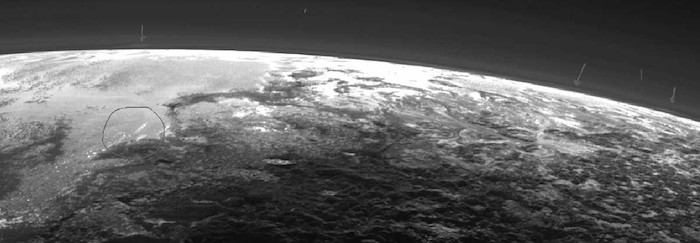
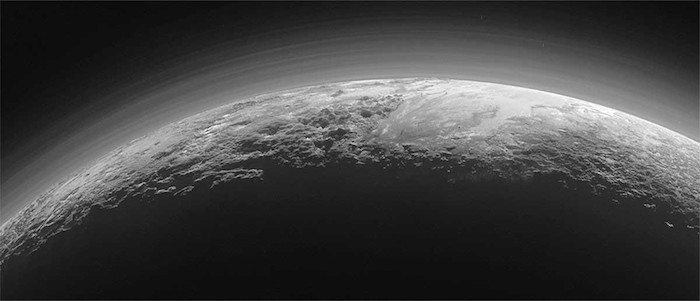
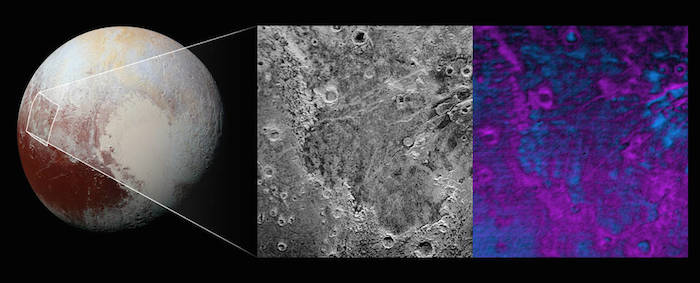

Pluto's Cthulhu region, about the size of Alaska, is characterized by reddish hues in contrast to the more pale, heart-shaped feature known as Sputnik Planum. Cthuhlu likely gets this darker color from tholins, complex organic molecules that form when ultraviolet light strikes simple organic molecules like methane. Tholins have been found on several worlds in the outer solar system, including Titan.
However, higher resolution images of mountains within the Cthulhu region have shown that the upper slopes on the highest peaks are much brighter. The most obvious explanation for this is a methane snow that has condensed out of Pluto's thin atmosphere, scientists say.
"That this material coats only the upper slopes of the peaks suggests methane ice may act like water in Earth's atmosphere, condensing as frost at high altitude," said John Stansberry, a New Horizons science team member from Space Telescope Science Institute in Baltimore, Maryland. Indeed, a spectral analysis found that the bright mountain peaks correlated nearly perfectly with the distribution of methane ice.
Quelle: ars technica
-
Update: 5.03.2016
.
Exclusive photos: Clouds seen on Pluto for first time

It can take a while to get a weather report from the outskirts of the solar system. The New Horizons spacecraft, which flew past Pluto last July, may have discovered clouds hovering above the surface, New Scientist can exclusively reveal.
Images released publicly (see bottom image) by the New Horizons team have already shown off Pluto’s surprisingly complex atmosphere, featuring many layers of haze rising above icy mountains. But in emails and images seen by New Scientist, researchers on the mission discuss the possibility that they have spotted individual clouds, pointing to an even richer atmospheric diversity.
The first sign of clouds came on 13 September last year, a few days before the public release of the haze pictures. Will Grundy of the Lowell Observatory in Arizona sent an email to a discussion list dedicated to analysing New Horizons results about Pluto’s atmosphere. “There’s a few fairly localized low-altitude features just above the limb that I’ve drawn lame arrows pointing to, but also a few bright cloud-like things that seem to be above and cutting across the topography in the circled area,” he wrote, attaching a picture (see below).
.

Grundy had spotted features in the haze on the edge – or “limb” – of Pluto that seemed to stand out from the distinct layers. But more intriguingly, he had also seen a bright feature crossing different parts of the landscape, suggesting it was hovering above.
The email kicked off a discussion as to whether the clouds were real, because it was difficult to see whether they cast shadows on the ground. The team also deliberated over the exact distinction between clouds and hazes. “One way to think of it is that clouds are discrete features, hazes widespread,” wrote Alan Stern, who heads up the New Horizons mission.
There has been no public mention of the clouds, suggesting that the team isn’t sure about the detection. In February emails, the team discussed a paper due to be published in the journal Science entitled “The Atmosphere of Pluto as Observed by New Horizons” which only mentions clouds in passing, as an as yet-unsolved mystery.
But an email sent by John Spencer of the Southwest Research Institute in Boulder, Colorado, on 1 March includes a picture (see top of article) of a cloud that seems to stand out from the surface. “In the first image an extremely bright low altitude limb haze above south-east Sputnik on the left, and a discrete fuzzy cloud seen against the sunlit surface above Krun Macula (I think) on the right,” he wrote.
.

The emails do not discuss what the clouds might be made of. They are likely to be of similar composition to the general atmosphere, which according to the team’s upcoming Science paper, consists of nitrogen, with traces of methane, acetylene, ethylene and ethane.
The emails suggest that the top cloud image has only just been downloaded from New Horizons. The probe has many gigabytes of data sitting in its memory but is hurtling further away from Earth, meaning it takes a long time to transmit its findings back – we won’t have the full data set until nearly the end of this year. Perhaps there are even more cloud pictures up there, waiting to be received.
Quelle: NS
-
Update: 11.03.2016
.
What’s Eating at Pluto?

Far in the western hemisphere, scientists on NASA’s New Horizons mission have discovered what looks like a giant “bite mark” on Pluto’s surface. They suspect it may be caused by a process known as sublimation—the transition of a substance from a solid to a gas. The methane ice-rich surface on Pluto may be sublimating away into the atmosphere, exposing a layer of water-ice underneath.
.

In this image, north is up. The southern portion of the left inset above shows the cratered plateau uplands informally named Vega Terra (note that all feature names are informal). A jagged scarp, or wall of cliffs, known as Piri Rupes borders the young, nearly crater-free plains of Piri Planitia. The cliffs break up into isolated mesas in several places.
Cutting diagonally across the mottled plans is the long extensional fault of Inanna Fossa, which stretches eastward 370 miles (600 kilometers) from here to the western edge of the great nitrogen ice plains of Sputnik Planum.
Compositional data from the New Horizons spacecraft’s Ralph/Linear Etalon Imaging Spectral Array (LEISA) instrument, shown in the right inset, indicate that the plateau uplands south of Piri Rupes are rich in methane ice (shown in false color as purple). Scientists speculate that sublimation of methane may be causing the plateau material to erode along the face of the cliffs, causing them to retreat south and leave the plains of Piri Planitia in their wake.
Compositional data also show that the surface of Piri Planitia is more enriched in water ice (shown in false color as blue) than the higher plateaus, which may indicate that Piri Planitia’s surface is made of water ice bedrock, just beneath a layer of retreating methane ice. Because the surface of Pluto is so cold, the water ice is rock-like and immobile. The light/dark mottled pattern of Piri Planitia in the left inset is reflected in the composition map, with the lighter areas corresponding to areas richer in methane – these may be remnants of methane that have not yet sublimated away entirely.
The inset at left shows about 650 feet (200 meters) per pixel; the image measures approximately 280 miles (450 kilometers) long by 255 miles (410 kilometers) wide. It was obtained by New Horizons at a range of approximately 21,100 miles (33,900 kilometers) from Pluto, about 45 minutes before the spacecraft’s closest approach to Pluto on July 14, 2015.
The LEISA data at right was gathered when the spacecraft was about 29,000 miles (47,000 kilometers) from Pluto; best resolution is 1.7 miles (2.7 kilometers) per pixel.
Quelle: NASA
5105 Views
